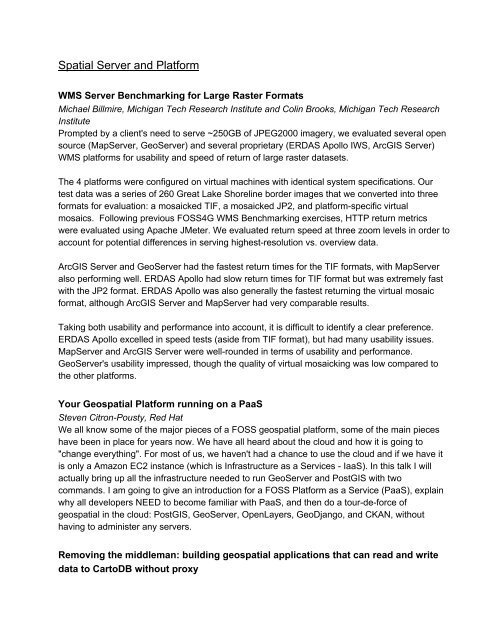FOSS4G North America Conference 2013 Preliminary Program
FOSS4G North America Conference 2013 Preliminary Program
FOSS4G North America Conference 2013 Preliminary Program
Create successful ePaper yourself
Turn your PDF publications into a flip-book with our unique Google optimized e-Paper software.
Spatial Server and Platform<br />
WMS Server Benchmarking for Large Raster Formats<br />
Michael Billmire, Michigan Tech Research Institute and Colin Brooks, Michigan Tech Research<br />
Institute<br />
Prompted by a client's need to serve ~250GB of JPEG2000 imagery, we evaluated several open<br />
source (MapServer, GeoServer) and several proprietary (ERDAS Apollo IWS, ArcGIS Server)<br />
WMS platforms for usability and speed of return of large raster datasets.<br />
The 4 platforms were configured on virtual machines with identical system specifications. Our<br />
test data was a series of 260 Great Lake Shoreline border images that we converted into three<br />
formats for evaluation: a mosaicked TIF, a mosaicked JP2, and platformspecific virtual<br />
mosaics. Following previous <strong>FOSS4G</strong> WMS Benchmarking exercises, HTTP return metrics<br />
were evaluated using Apache JMeter. We evaluated return speed at three zoom levels in order to<br />
account for potential differences in serving highestresolution vs. overview data.<br />
ArcGIS Server and GeoServer had the fastest return times for the TIF formats, with MapServer<br />
also performing well. ERDAS Apollo had slow return times for TIF format but was extremely fast<br />
with the JP2 format. ERDAS Apollo was also generally the fastest returning the virtual mosaic<br />
format, although ArcGIS Server and MapServer had very comparable results.<br />
Taking both usability and performance into account, it is difficult to identify a clear preference.<br />
ERDAS Apollo excelled in speed tests (aside from TIF format), but had many usability issues.<br />
MapServer and ArcGIS Server were wellrounded in terms of usability and performance.<br />
GeoServer's usability impressed, though the quality of virtual mosaicking was low compared to<br />
the other platforms.<br />
Your Geospatial Platform running on a PaaS<br />
Steven CitronPousty, Red Hat<br />
We all know some of the major pieces of a FOSS geospatial platform, some of the main pieces<br />
have been in place for years now. We have all heard about the cloud and how it is going to<br />
"change everything". For most of us, we haven't had a chance to use the cloud and if we have it<br />
is only a Amazon EC2 instance (which is Infrastructure as a Services IaaS). In this talk I will<br />
actually bring up all the infrastructure needed to run GeoServer and PostGIS with two<br />
commands. I am going to give an introduction for a FOSS Platform as a Service (PaaS), explain<br />
why all developers NEED to become familiar with PaaS, and then do a tourdeforce of<br />
geospatial in the cloud: PostGIS, GeoServer, OpenLayers, GeoDjango, and CKAN, without<br />
having to administer any servers.<br />
Removing the middleman: building geospatial applications that can read and write<br />
data to CartoDB without proxy


